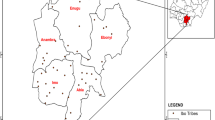Abstract
Some locally available fruits and vegetables of the arid zone of Rajasthanwere analyzed for their β-carotene content; the selected fruits and vegetables were: Dansra (Rhus myserensis), Kachri (Cucumis collosus), fruit Kachri (Cucumis collosus), Kair (Capparisdecidua) and Sanghri (Prosopis cineriria). The β-carotene contents of the samples were estimated in fresh and various processed states (blanched, dried and roasted). The results showed the heat lability of β-carotene. Among the samples, kair was found to be the richest source of β-carotene. Variety, too, had an impact on the content of this fat soluble vitamin.
Similar content being viewed by others
References
Machlin LT (1984) Handbook of Vitamins, Nutritional, Biochemical and Clinical Aspects. New York: Marcel Dekker, 1.
Goodwin TW(1986) Metabolism, nutrition and functions of carotenoids. Annu Rev Nutr 6: 273.
Dashorra MS, Dikshit VP, Sharma I (1992) Effect of Kair on rabbits with hyper cholesterolemia. J Ayurveda 13: 43–47.
Sharma P (1956) Dravyaguna Viznana Vol. III, Vegetable Drugs, Choukhambha Vidya Bhawan, Varanasi, pp 207, 306, 434, 530-532, 546, 565.
Mishra B (1969) Bhav Prakash Nighantuu, Tikakar K.C. Chunekar, Vatadivarg (33) Choukhambha Vidya Bhawan, Varanasi, pp 306, 355, 546, 598.
Harris RS, Karmas E (1975) Nutritional Evaluation of Food Processing. Connecticut, IL: AVI, Publishing Co., p 205.
Determination of Carotene (Provitamin A). Hawk's Physiological Chemistry, 14th edn. Oser, Summerson (eds), 14th edn, pp 590–591.
Gopalan C, Rama Sastri BV, Bala Subramanian SC (1996) Nutritive Value of Indian Foods. Hyderabad: Indian Council of Medical Research, pp 63, 94.
Rodrigo M, Lazaro MJ, Alavarruiz A, Ginger V (1992) Composition of Capers (Capparis Spinosa): Influence of cultivar, size and harvest date. J Food Sci 57: 1152–1154.
Yadav SK, Sehgal S (1997) Effect of home processing and storage on ascorbic acid and _-carotene content of Bathua (Chenopodium album) and fenugreek (Trigonella foenum graecum) leaves. Plant Food Hum Nutr 50: 239–247.
Padmavati K, Udipi S, Rao M(1992) Effects of different cooking methods on _-carotene content of vegetables. J Food Sci Technol 29: 137–140.
Rao NC (1967) The Vitamin A value of some vegetables. J Nutr Diet 4: 10.
Author information
Authors and Affiliations
Rights and permissions
About this article
Cite this article
Chaturvedi, Y., Nagar, R. Levels of β-carotene and effects of processing on selected fruits and vegetables of the arid zone of India. Plant Foods Hum Nutr 56, 127–132 (2001). https://doi.org/10.1023/A:1011174400658
Issue Date:
DOI: https://doi.org/10.1023/A:1011174400658




